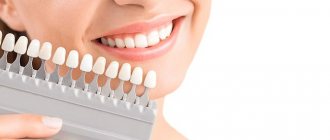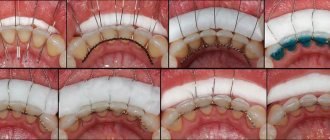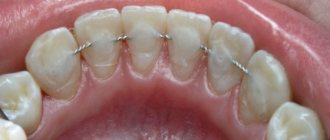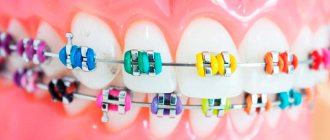Publication date: June 01, 2022.
Information on this page was updated on December 30, 2021.
Orthodontic treatment does not end with the removal of braces, because immediately after removal, the bone tissue and ligaments will begin to return to their original position and move the teeth. To consolidate the result after removing braces, it is necessary to install retention structures that will hold the teeth in the correct position until the bone tissue is finally formed around the roots of the teeth.
- What are retainers?
- Fixed retainers
- Removable retainers and mouthguards
- Combined
- How do retainers work?
- How long should retainers be worn?
- The process of installing permanent retainers
- How to care for retainers?
- Which is better: mouthguards or retainers?
- Frequently asked questions about retainers
- What problems can arise with a retainer?
- Reviews about retainers
Fixed retainers
A permanent retainer is a wire arch made of medical steel, which is attached to the inside of the teeth with a special compound. This type of retainer is used most often, as they are completely invisible, cannot be felt in the mouth and do not oxidize. Fixed retainers can come off due to mechanical stress, such as chewing hard food. In this case, you should immediately visit the orthodontist and return the retainer to its place to prevent the teeth from moving.
Fixed retainers have many advantages: you can’t forget to put them on - they are always on your teeth, and they are absolutely invisible and do not interfere. The main feature of wearing a fixed structure is the need for careful home hygiene and professional cleaning every six months at the dentist, since plaque in hard-to-reach places around the retainer is more difficult to clean.
Types of retainers
The classification of these devices is based on the degree of transparency of the material, the method of wearing and fastening. Installation of a retainer is carried out only after a thorough analysis of many factors relating to the individual characteristics of the patient’s body.
Retainers are divided into the following types of designs:
- Retainers are removable type.
- Retainers are non-removable type.
- A combination of several device options.
- Fixed retainer
A non-removable retainer can be characterized as follows:
1. Their appearance is like a thin and inconspicuous arc. Either tape or fiber system.
2. They can be made exclusively from modern metals.
3. Their fastening is carried out from the inside of the dentition. For fixation, we use a specific adhesive composition.
4. Fixation is carried out exclusively to the molars.
5. Requires systematic observation by an orthodontist. The doctor must periodically assess the situation; his special attention is focused on those teeth on which retainers are attached.
7. Installed retainers require not simple hygiene, but systematic professional cleaning.
8. The course of treatment is continuous. This quality can be considered both an advantage and a disadvantage, because there is a combination of a more pronounced effect with a significant difficulty in implementing hygiene measures. And the slightest inattention to a certain area of the oral cavity can cause the formation of tartar deposits. But you won’t have to clean them often.
Removable retainers and mouthguards
Removable retention structures come in two types:
- Plastic plates with a metal arch that encircles the dentition;
- Transparent mouth guards made of silicone.
After braces are removed, mouthguards or plates must be worn constantly, removed only during meals, brushing teeth, or public speaking. In the future, on the recommendation of a doctor, the time of wearing retention structures is reduced: they are removed at night and worn less during the day. Removable structures can be noticeable to others, and at first they affect diction and cause increased salivation. Typically, removable retainers are prescribed at the end of the retention period after fixed structures, but they can also be used independently throughout the entire retention period.
Plastic plates with metal arc
Silicone transparent mouth guard
Removable systems
Removable structures include mouth guards and plastic plates with a metal bracket. They are worn during the day and removed when eating. It is recommended to remove the plates at night. The design is fragile and may break. The trays can be left overnight.
Mouthguards are made of silicone, plastic or gels with a film or fibrous structure. The products are transparent and not visible when you smile. A contraindication may be individual intolerance to the material. If the patient has had a complex malocclusion corrected, then mouthguards are not recommended to consolidate the result.
- Standard mouth guards can be purchased at a pharmacy. Their price is low. It is not possible to adjust them to size; this is their inconvenience. In addition, the design itself is cumbersome. The patient may experience discomfort when wearing it, and breathing problems may occur.
- Thermoplastic mouth guards are more physiological. They are kept in hot water and then put on the teeth. After cooling, the product will press tightly to the teeth.
- The orthodontist can make a mouth guard individually for the patient. It will include all the features of the teeth. It will not cause discomfort.
During the first years, the mouth guard will have to be worn every day. Towards the end of the retention period, it can be worn a couple of times a week. The product is rinsed with warm water each time before putting it on.
How do retainers work?
Braces or aligners actively move teeth in the desired direction due to the traction of the arch and pressure on the dentition. A non-removable wire retainer does not put pressure on the teeth, but only holds them in the desired position, preventing them from moving apart. Removable aligners differ from aligners in that they are not used with attachments (activators of tooth movement), but exactly repeat the shape of the dentition and fit tightly to the teeth, fixing the dentition. Any retention structure does not move the teeth, but at the same time it should prevent the ligaments from relaxing and returning to their previous position until the bone tissue around is completely strengthened.
Wearing time per day
In the table we consider the time of wearing retainers:
| Fixed | Removable | |
| 1-3 months | 24 hours a day | 22 hours a day |
| 3-6 months | 24 hours a day | 20 hours a day |
| 6-9 months | 24 hours a day | 18 hours a day |
| 9-12 months | 24 hours a day | 12 hours a day |
| 12-18 months | 24 hours a day | 8 hours a day |
| 18-36 months | 24 hours a day | 8 hours a day every other day |
Important! You should not insist on choosing a removable or non-removable retainer model. The decision about what to wear and for how long should be made by the doctor, guided by the orthodontist's condition and taking into account the patient's preferences.
How long should retainers be worn?
The duration of the retention period is on average 2 times longer than wearing braces, and patients who corrected their bite in adulthood - after 25-30 years, can wear retainers all their lives.
The length of time you wear retainers usually varies from person to person and depends on the following factors:
- Age of the orthodontic patient. The younger a person is, the faster his ligaments and muscles are rebuilt, thereby fixing the teeth and bite in the correct position. For patients who received braces as teenagers, wearing retainers for 6 months to 2 years is sometimes sufficient.
- Bad habits. People who smoke have poor blood supply and reduced immunity, so all processes of restructuring the position of teeth and healing are slower than in non-smokers.
- Oral health. If the teeth and periodontal tissues are healthy, the fixation of the ligamentous apparatus occurs faster.
- Complexity of the clinical case. The stronger the initial curvature of the teeth, the longer you need to wear a retainer.
The retention period must be carried out under the supervision of an orthodontist so that he monitors the condition of the bite. In any case, you should not stop wearing retainers without your doctor's approval, otherwise your teeth may become crooked again.
Consequences of violating the orthodontist's prescriptions
The structures that are placed after braces must be worn strictly following the instructions of the orthodontist. Some people stop treatment on their own without a doctor’s approval, wear retainers for insufficient hours, and sometimes even unfasten permanent archwires themselves.
The retention period of bite correction is very important to achieve long-term results. In case of unauthorized violation of the prescribed terms of wearing retainers, the risk of the return of the abnormal position of the teeth is very high. Moreover, failure to comply with the doctor’s recommendations can lead not only to the re-development of malocclusion pathology, but also to a worsening of the situation.
The process of installing permanent retainers
Retainers are installed after braces are removed on completely healthy teeth after professional hygiene. The patient may need to undergo oral sanitation after orthodontic treatment. While wearing braces, it is difficult to clean your teeth perfectly, and accumulated plaque can cause caries and tartar. Retainers cannot be installed on affected teeth, since another design in the mouth will again complicate hygiene and lead to a deterioration in the condition of the oral cavity. Also, during orthodontic treatment, the enamel may become thinner, so in addition to hygienic cleaning, teeth need fluoridation and mineralization.
After carrying out therapeutic and preventive measures, the orthodontist begins the laboratory stage of manufacturing retainers. An impression is taken from healthy teeth, according to which the retainer is given the necessary shape of the dentition.
Before the actual installation of the retainer, the teeth are etched with a special solution so that their surface becomes slightly rougher for better adhesion. In some cases, instead of etching the teeth, the teeth are prepared: a microgroove is drilled on the inside to fix the retainer. Once the teeth are prepared, the retainer is placed in the desired position and secured with composite material. The procedure is completed by grinding the material for the patient’s convenience.
The installation procedure takes 15-20 minutes and is absolutely painless. But in the first days of adaptation, the retainer can rub and reduce the clarity of diction.
Installation of retainers in pediatric dentistry: stages
A retainer is placed immediately after the braces are removed. Even short pauses in treatment are unacceptable, as this negatively affects the correction.
Installation of retainers takes place in several stages:
- Preparation.
The doctor carefully removes the braces from the teeth. After which he carries out professional cleaning to remove any remaining glue, and checks the teeth for caries and external damage. Dental crowns must be treated with a substance to ensure reliable adhesion of the enamel to the composite material.
- Manufacturing and installation of retainers.
When the orthodontist is convinced that wearing braces has not damaged the teeth, a retention system is installed. An orthodontic splint made of wire is fixed with composite compounds. When choosing a removable appliance, the doctor first takes impressions, and after making the aligners or plates, fixes the structure on the teeth. In some cases, ready-made solutions are selected for the patient - thermoplastic aligners for quick adjustment or trainers of a suitable size.
- Consultation.
At the end of the appointment, the doctor will tell you how long to wear retainers after braces, how to care for the device, and when to come for a routine examination.
After the prescribed wearing interval, the retainers are removed. The patient copes with removable structures independently. A visit to the doctor is required to remove the permanent option.
Orthodontists at Aza&Buka pay attention to the duration of the retention period. Since there is no way to monitor the formation of new bonds and tissues, it is worth wearing a retainer for as long as possible. This guarantees a consistently long-term correction result - for decades or for life.
How to care for retainers?
Retainers, like any structure in the mouth, without careful hygiene provoke the accumulation of bacteria, the appearance of plaque and caries.
- You can brush your teeth with a regular toothbrush and toothpaste, but be careful when brushing the inside of your teeth if you have a permanent retainer;
- If the retainer comes unstuck, you need to visit the orthodontist and return it to its place so that an orthodontic relapse does not occur;
- For thorough hygiene when wearing fixed retainers, it is recommended to use a waterpik, brushes and dental floss to clean hard-to-reach places near the arch;
- Removable retainers and mouth guards should be washed with disinfectants, soap, or brushed with toothpaste at least 2 times a day.
- Mouthguards must be removed when eating and smoking and stored in special containers;
- Mouthguards should not be washed with hot water because they will become deformed.
- To strengthen the enamel, it is recommended to rinse the mouth with a fluoride solution.
After braces are removed and retainers are installed, you should periodically visit the orthodontist for follow-up examinations and the hygienist to maintain oral health. Only after the end of the retention period can orthodontic treatment be considered complete.
What are the pros and cons
The pros and cons of retainers after braces are removed depend on the type of design used. The general advantages are the consolidation of the treatment result, after which the doctor can guarantee that the teeth will remain straight for many years.
Advantages and disadvantages of fixed models
The main advantages of models that are permanently attached to the bite are:
- constant impact on the tooth, reducing the risk of reducing the effectiveness of procedures;
- absence of unpleasant sensations during the installation of retainers and their subsequent wearing;
- quick adaptation to the product (some get used to it immediately, others within a week);
- absence of external signs of the presence of a dental retainer , which is especially important for patients who need to work with people.
Patients who use such models say that a non-removable retainer is a tool that creates inconvenience only at first. Brushing your teeth is a little difficult at first, but compared to cleaning your teeth while wearing braces, it's nothing. Also considered disadvantages are the need to visit the dentist and periodic damage to the wire, due to which it is necessary to organize an unscheduled visit to the doctor.
Many people choose non-removable models, because such a retainer is not visible in the photo and it does not interfere with the smile. If you don't tell the person you're wearing a device, no one will know about it.
Advantages and disadvantages of removable models
The removable retainer gets a lot of good reviews thanks to the following advantages:
- you don’t need to wear it all the time, you can put it on only at night (the timing and regularity of wearing it depend on your doctor’s recommendations);
- allows you to get a break from the presence of hard structures in the mouth after treatment with braces;
- Easy to clean with a special brush and paste.
The main disadvantage of the appliance is that it is a visible dental retainer . During the day, when the plate is in the mouth, it significantly changes the appearance of the smile. This can cause complexes and inconveniences. Also, for some, the design leads to increased salivation, which is quite inconvenient.
There are cases when a doctor prescribes the installation of two types of retainers at once: a fixed structure on one jaw and wearing a mouthguard on the other.
Which is better: mouthguards or retainers?
Retention mouthguards and a non-removable retainer after orthodontic treatment are used in combination: a non-removable retainer from canine to fang is permanently placed on the teeth, the mouthguard is put on at night. After removing braces, we give patients 2 mouthguards: a night guard for all teeth in the upper dentition and a canine-to-canine safety mouthguard for the lower dentition, which is needed if the retainer breaks and there is no way to quickly make an appointment with an orthodontist. From the point of view of patient comfort, a non-removable retainer is more convenient than a mouth guard, since a week after installation, it is practically not felt in the mouth. And the mouth guards are quite bulky and it’s more difficult to get used to them.
Why are retainers needed?
At an early stage, when treatment with braces was just developing, orthodontists believed that after the correction was completed and the structure was removed, the teeth would forever remain in their new, ideal position. Unfortunately, after several months or years, most patients complained that after removing braces, the teeth gradually changed their position, and sometimes even returned to their original position, as before treatment. Many patients had to have their braces re-attached and wear them for several more years. This was especially true for people whose age at the time of correction was 20 years or older; in children, relapses were observed much less frequently.
It turned out that the reason lies in the structure of the teeth. Between the tooth and the jaw bone there are many blood vessels and ligaments. The brace, under the action of the arc, pulls the tooth to a new place, stretching the ligaments and blood vessels. The bone surrounding the tooth also gradually changes: on one side it slowly decreases, and on the other it increases. The older the patient, the longer it takes to change bone tissue , since after 30 years it is stronger and denser.
After the system is removed, no further force affects the tooth, bone, vessels and ligaments, so they begin to return to the places they occupied before treatment. It is precisely in order to prevent teeth from becoming crooked again that retainers are needed after braces .
Frequently asked questions about retainers:
Typically, patients who are thinking about installing braces learn about the need to wear a retainer during a consultation with an orthodontist. We have collected the most common questions that patients ask about the retention period.
How long to wear a retainer?
The minimum period for an adult patient is twice as long as the period of orthodontic treatment. Our recommended period is from 5 to 10 years, depending on the complexity of the case and the type of retention. Many patients do not feel the retainer on their teeth and quietly wear it all their lives.
Is it possible to do an MRI with a retainer?
Yes, an MRI can be done with a retainer, just like with braces, but due to the presence of metal in the mouth, there may be interference in the final image.
Do I need to change my permanent retainer?
If the retainer is not broken or unstuck, then there is no need to change it. To maintain good hygiene in the retainer area, use a single-tuft brush, brushes, dental floss, and regular professional hygiene.
Is there a warranty for the retainer?
In our clinic, the warranty on the retainer lasts 2 years. If during this time the retainer breaks or comes off, we will replace it absolutely free of charge.
Can teeth move apart if a retainer is installed?
If orthodontic treatment is completed correctly - the correct closure and position of the teeth is achieved, then with a permanent retainer, the teeth will remain in the correct position. If the retainer comes unstuck or breaks, you need to install it as quickly as possible, since even in a month your teeth can change position.
Answers to popular questions
Can a retainer cause tartar to form on my teeth?
No, he can not. But if you don't take good care of your teeth, you run the risk of developing caries.
Why does the doctor prohibit MRI?
If you have a metal retainer, MRI is not allowed, as the equipment generates powerful magnetic fields. If the retention apparatus is made of fibrous non-metallic compounds, then there is no prohibition.
What to do if your retainer comes off?
A loose retainer should be returned to its place as quickly as possible, especially if treatment with braces has only recently ended. When wearing a retention structure for a long time, it is acceptable to wait a few days, but you should not delay it either.
Is it possible to do without a retainer?
No you can not. The teeth will return to their original position, which means that orthodontic treatment was carried out in vain.
Do wearing retainers hurt?
No. Patients stop noticing the wire already 2-3 days after installation. Removable options also do not cause discomfort when worn.
Did not find an answer to your question?
What problems can arise with a retainer?
The first thing a person who has a permanent retainer installed will face is getting used to it. At first, the retainer may rub your tongue, feel too big in your mouth, and interfere with clear diction. The retainer becomes invisible in the mouth after about a week.
The next task for a patient with a retainer is careful home hygiene, since food debris can get stuck in the spaces between the teeth and the retainer. For home cleaning, we recommend using a single-tuft brush, brushes, dental floss and irrigator.
The retainer may break or come off due to hard foods. In this case, you need to contact your doctor for a replacement.
If caries appears in the area of the retainers on the teeth, then for treatment by a therapist, the retainer will need to be removed and then reinstalled.
Consequences of violating the terms and conditions of wearing a retainer
Visible problems from violating the rules of wearing retainers appear after a year or more
Some patients seek to reduce the time they wear a retainer and remove them earlier than expected.
Having gone without it for several weeks or months, they do not notice any special changes and finally refuse to wear it.
Visible problems arise after a year or more - the smile is no longer so flawless.
And to restore it, you will again need to order a brace system, and wear it almost as much as during the initial treatment.
Is it worth spending money and experiencing discomfort if it can be easily avoided by following the dentist’s recommendations.
Wearing a retainer beyond the established daily time and period is also undesirable. Once the bone tissue around them has formed, they do not require additional fixation.











